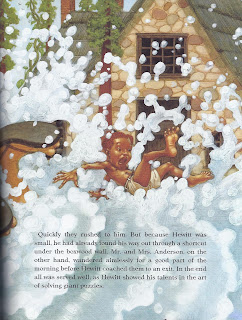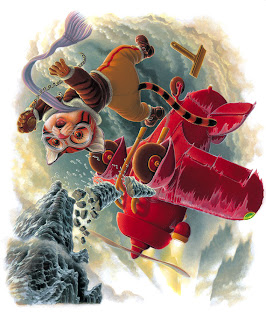Monkey with a Tool Belt and the Noisy Problem by Chris Monroe appears with the permission of Lerner Publishing Group, Inc. Text and illustrations copyright ©
2009 by Chris Monroe
Chico Bon Bon is a very handy monkey who resides in a tree house. He is never without his tool belt, even while he slumbers. Chico owns the usual tools, like a measuring tape, screwdriver and saw, but he also has the following: "chopper, chippper, bopper, bipper, tacker, clacker, snicker-snacker, nail finder, candy finder, plug wrench, lug wrench, pug wrench, bug wrench, razzler, frazzler, frizzler, twizzler, de-twizzler, lid lifter, pickle picker, jibber, jabber, paper scraper, glitter vac, putty splapper, tail clamp, sponge brush, hook-on-a-stick."
One morning, Chico's sleep is disturbed by a loud, unusal noise
,"AROOGA BOOM CLANG CLANG." Chico assumes that the sound is coming from what appears to be a gale force wind that is blowing through his open window. He closes the window - the noise, however, continues. Chico walks around the house to search out the source. He checks the bread box, the hamper, under the floorboards, his swimming pool, among others places, without luck. Chico imagines all types of farfetched scenarios that would explain the noise: woodpeckers playing tricks on him, a monster, a spacecraft on the roof. Chico's tree house is quite palatial, with four levels that are accessed by ladders, slides and fireman poles.
After searching every inch of the house, he discovers that the noise is emanating from the laundry chute. He cannot see what is in the chute when he looks down, because dirty clothes are on top of whatever is stuck there. When Chico goes to the basement to look up, this is what he sees:
a friendly elephant named Clark. Clark explains that he wandered into Chico's tree house by accident that night, thinking it was his friend Elsa's.
Chico ponders how to rescue Clark, who is wedged in pretty tight. Once he has a plan, he pulls out his tools and gets to work. I won't tell you exactly how Clark is rescued, but it involves atypical tools: a banana cannon and a sticky winch.
Monkey with a Tool Belt and the Noisy Problem is the second book in the now three book series. We have read the first book,
Monkey with a Tool Belt, numerous times. We have not yet read the third title,
Monkey with a Tool Belt and the Seaside Shenanigans which was just released this past summer. It has the word "shenanigans" in the title, so it has to be amusing.
The boys enjoy this series for several reasons.
First, there is a monkey and his name is almost impossible to say and not smile. Try it yourself - "Chico Bon Bon." You're grinning aren't you?
Second, the kids are going through a tree house phase. Boy, do they want us to build one. Since that will not be happening any time soon, they have contented themselves repeatedly scrutinizing every room of Chico Bon Bon's tree house. I have to admit, I want that tree house for myself. Our home resembles a hovel compared to Chico's mansion in the sky!
Third, we also have a laundry chute, so the kids find it amusing to peer down it and imagine seeing an humongous elephant or other peculiar animals wedged in there.
Fourth and most importantly, there are tools. Like Chico, the boys consider themselves to be quite handy. They recite the silly names of the tools and guess their purpose. After reading step-by-step how Chico rescues Clark, they discuss alternative plans and tools that could have been used. Chico Bon Bon, Chico Bon Bon, Chico Bon Bon we love you!

















































